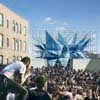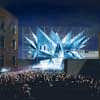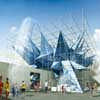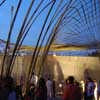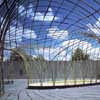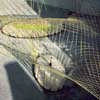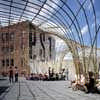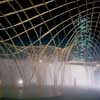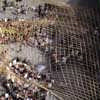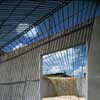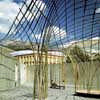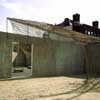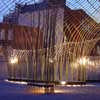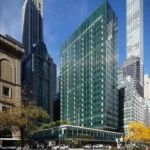P.S.1 Contemporary Art Center New York, MoMA PS1, YAP Building Design, Architecture Images
P.S.1 Contemporary Art Center Canopy : YAP New York
Canopy Structure at MoMA PS1, Long Island City, Queens, NY, USA
Feb 14, 2012
MoMA / P.S.1 Young Architects Program Winner
HWKN wins the 2012 Young Architects Program at MoMA PS1 in New York
New York based office HWKN (HollwichKushner) announced by The Museum of Modern Art and MoMA PS1 as winner of the annual Young Architects Program (YAP) in New York.
As winners of the 13th edition of the program, HWKN will construct an outdoor summer installation at the PS1 courtyard in Long Island City. The winning proposal, known as ‘Wendy’, was selected from five finalists and will provide a setting for the popular Warm Up summer music series.
HWKN state: “Wendy does not play the typical architecture game of ecological apology – instead she is pro-active. That is why Wendy is composed of nylon fabric treated with a ground breaking titania nanoparticle spray to neutralize airborne pollutants. During the summer of 2012 Wendy will clean the air to an equivalent of taking 260 cars off the road. Wendy’s boundary is defined by tools like shade, wind, rain, music, and visual identity to reach past the confines of physical limits. Wendy crafts an environment – not just a space. Spikey arms reach out with micro-programs like blasts of cool air, music, water canons and mists to create social zones throughout the courtyard.”
HWKN (HollwichKushner) SELECTED AS WINNER OF THE 2012 YOUNG ARCHITECTS PROGRAM AT MoMA PS1 IN NEW YORK
HWKN’S Wendy to Provide the Setting for the Warm Up Summer Music Series in the Courtyard of MoMA PS1
The Museum of Modern Art and MoMA PS1 announce HWKN (Matthias Hollwich and Marc Kushner, New York) as the winner of the annual Young Architects Program (YAP) in New York. Now in its 13th edition, the Young Architects Program at MoMA and MoMA PS1 has been committed to offering emerging architectural talent the opportunity to design and present innovative projects, challenging each year’s winners to develop creative designs for a temporary, outdoor installation at MoMA PS1 that provides shade, seating, and water. The architects must also work within guidelines that address environmental issues, including sustainability and recycling.
HWKN, drawn from among five finalists, will design a temporary urban landscape for the 2012 Warm Up summer music series in MoMA PS1’s outdoor courtyard. The winning project, Wendy, opening at MoMA PS1 in Long Island City in late June, is an experiment that tests how far the boundaries of architecture can expand to create ecological and social effect. Wendy is composed of nylon fabric treated with a ground breaking titania nanoparticle spray to neutralize airborne pollutants. During the summer of 2012, Wendy will clean the air to an equivalent of taking 260 cars off the road.
Wendy’s boundary is defined by tools like shade, wind, rain, music, and visual identity to reach past the confines of physical limits. Wendy crafts an environment, not just a space. Spiky arms made of the nylon fabric mentioned above will reach out with micro-programs like blasts of cool air, music, water cannons and mists to create social zones throughout the courtyard.
Wendy sits far enough away from the stage used for the annual Warm Up events to let the concerts go on unimpeded, but close enough to the entrance to create a filter and initial impact to visitors. It bridges over the walls into the large and small courtyards of MoMA PS1. Wendy features a simple, inexpensive construction system: the scaffold is deployed efficiently to create a 70’ x 70’ x 45’ volume to form the largest surface area possible.
“The jury was greeted with a particularly impressive group of proposals this year, all of which represented months of sustained research into problems both specific to a summer installation at MoMA PS1 and to new directions for architecture in terms of material research, ecological responses, and recyclability,” said Barry Bergdoll, The Philip Johnson Chief Curator of Architecture and Design at MoMA.
“HollwichKushner’s design is at once based in emerging science of materials related to environmental cleansing—the material actually removes the carbon dioxide emissions produced by cars in Long Island City—but also on a zany quest for a space that is simply good fun. Even passengers on the elevated 7 train will feel compelled to head to MoMA PS1 to experience Wendy and figure out what in the world it can possibly be all about.”
“HollwichKushner is proposing a monumental gesture in the MoMA PS1 courtyard that, in its dimension and volume, creates a dialogue with the, at the moment, currently installed geodesic dome,” added Klaus Biesenbach, Director of MoMA PS1 and Chief Curator at Large at MoMA. “While the dome hosts our winter series SUNDAY SESSIONS, Wendy will enhance the courtyard environment for our famed summer Warm Up series. The project is not only innovative but also visualizes ecological awareness and responsibility.”
“HollwichKushner’s proposal for YAP 2012 is sure to make a memorable impression over the summer at MoMA PS1,” said Pedro Gadanho, Curator in MoMA’s Department of Architecture and Design. “It is iconic, but with a twist. By combining off-the-shelf materials and scaffolding systems with the latest cry in nanotechnology it is able to produce both an out-of-the-box ecological statement and a bold architectural gesture. It is economical and terse in terms of its design, and yet, through its positioning and scale, it also smartly projects different possibilities for use and social appropriation across the entire site where it sits—including the ability to reach out for those outside the museum’s walls.”
The other finalists for this year’s MoMA PS1 Young Architects Program were AEDS|Ammar Eloueini Digit-all Studio (Ammar Eloueini, Paris, France/New Orleans, LA), Cameron Wu (Cambridge, MA), Ibañez Kim Studio (Mariana Ibañez and Simon Kim, Cambridge, MA), and UrbanLab (Martin Felsen and Sarah Dunn, Chicago, IL). An exhibition of the five finalists’ proposed projects will be on view at MoMA over the summer, organized by Barry Bergdoll, MoMA Philip Johnson Chief Curator, with Whitney May, Department Assistant, Department of Architecture and Design, The Museum of Modern Art.
YAP International
MoMA and MoMA PS1 have partnered with the National Museum of XXI Century Arts (MAXXI) in Rome, and with CONSTRUCTO in Chile to create international editions of the Young Architects Program. Established in 2011, YAP MAXXI continues the YAP mission of offering young designers an opportunity to create a space for live summer events in the piazza of the MAXXI – National Museum of the 21st Century Arts in Rome.
The winner of the 2012 YAP MAXXI installation will be selected on February 20 from the following five finalists, Salvator (Napoli, Italy/Tokyo, Japan, John A. Liotta, Matteo Belfiore with Taichi Kuma and Yuto Ito); Rural Boxx, Sacile (Pordenone, Italy, Alessandro Zorzetto, Francesca Modolo, Luciano Aldrighi, Jacopo Toso, Luca Vivan); Urban Movement Design (New York, New York) with Studio REMOTO (Rome, Italy) Robyne Kassen, Sarah Gluck, Simone Zbudil Bonatti; 6MU6 (Torino, Italy, Valentina Toscano, Stefano Verrocchio), and Yellow Office (Milano, Italy, Francesca Benedetto, Dong Sub Bertin).
YAP Chile continues YAP’s legacy of providing an active platform to create new opportunities for talented Latin American emerging architects to think, explore, and improve the quality of collective-use spaces for live summer events, thinking on sustainability as a way to respond to a contemporary problem that requires intelligent and creative use of resources.
The 2011 winning design, Water Cathedral Project by GUN Architects, featured a large, horizontal urban nave for public use made up of numerous slender, vertical components, which hung or rose like stalactites and stalagmites in a cave, varying in height and concentration, providing shade under a canopy. The project, which was installed from December 15, 2011 until February 5, 2012, incorporated water dripping at different pulses and speeds from these hanging elements, fed by a hydraulic irrigation network.
ABOUT HWKN (HollwichKushner)
HWKN is a New York based architecture and design firm that specializes in architecture and branding. HWKN acts as incubator, location scout, producer, and developer, to ensure a project’s success. The firm’s work is a synthetic mix of progressive architectural concepts and pop culture that repurposes the best traditions of architecture for the contemporary client and their high-speed demands. HWKN’s work has been featured in The New York Times, Wallpaper*, Bauwelt, Architects Magazine, Dwell, Surface, Men’s Vogue, A+U, and many other publications.
The partners have lectured at TED_U, TED_X Atlanta, PICNIC in Amsterdam and many other locations on the topics of architecture and branding, aging and social media. In 2009 the firm cofounded Architizer.com – the largest and fastest growing platform for architects to show their work to the world.
MoMA PS1 Young Architects Program – HISTORY
This year marks the fifteenth summer that MoMA PS1 has hosted a combined architectural installation and music series in its outdoor galleries, though it is only the thirteenth year of the Young Architects Program, which began in 2000. The inaugural project was an architecturally based installation in 1998 by an Austrian artist collective, Gelatin.
In 1999, Philip Johnson’s DJ Pavilion celebrated the historic affiliation of MoMA PS1 and MoMA. The previous winners of the Young Architects Program are SHoP/Sharples Holden Pasquarelli (2000), ROY (2001), William E. Massie (2002), Tom Wiscombe / EMERGENT (2003), nARCHITECTS (2004), Xefirotarch (2005), OBRA (2006), Ball-Nogues (2007), WORKac (2008), MOS (2009), Solid Objectives – Idenburg Liu (2010), and Interboro Partners (2011).
YOUNG ARCHITECTS PROGRAM WEBSITE
A dedicated YAP International website, MoMA.org/YAP, will feature the selected proposals and designs from HWKN, winner of YAP IN New York, and as well as the winners of YAP MAXXI and YAP Chile. The website will also include an archive of past MoMA/MoMA PS1 finalists’ and winners’ proposals, interviews with the curators as well as installation videos.
Young Architects Program 2012 – SELECTION PROCESS
For the Young Architects Program 2012 selection process, MoMA and MoMA PS1 invited outside experts in the field of architecture, including architects, curators, scholars, and magazine editors, to nominate the finalists from a pool of approximately 25 candidates that included both recent graduates and established architects experimenting with new styles or techniques.
After reviewing the candidates, five finalists were selected to present proposals to a panel composed of Glenn D. Lowry, MoMA Director; Kathy Halbreich, MoMA Associate Director; Peter Reed, MoMA Senior Deputy Director of Curatorial Affairs; Barry Bergdoll, MoMA Philip Johnson Chief Curator, Department of Architecture and Design; Klaus Biesenbach, MoMA PS1 Director and MoMA Chief Curator at Large; Peter Eleey, MoMA PS1 Curator; Pippo Ciorra, Senior Curator, MAXXI Architettura; Jeannette Plaut, Director, YAP_Constructo; and Marcelo Sarovic, Director, YAP_Constructo.
MoMA PS1 – PUBLIC INFORMATION
MoMA PS1: 22-25 Jackson Ave at the intersection of 46th Avenue in Long Island City, Queens Hours: Noon-6:00 p.m. Thursday through Monday; closed on Tuesdays and Wednesdays.
Admission: Admission is a $10.00 suggested donation; $5.00 for students and senior citizens; free for MoMA members and MoMA admission ticket holders. The MoMA ticket must be presented at MoMA PS1 within thirty days of date on ticket and is not valid during Warm Up or other MoMA PS1 events or benefits. The public may call 718/784-2084 for additional information.
Visit us on the Web at MoMAPS1.org.
MoMA PS1 Young Architects Program (YAP) in New York winner – external link
MoMA PS1 Young Architects Program 2016
Previously:
CANOPY: MoMA / P.S.1 Young Architects Program
Canopy was a temporary structure built with green bamboo in the courtyard of P.S.1, a contemporary art and music venue whose weekly Warm Up music parties attract 8,000 revelers every Saturday in the summer. Museum goers lounge, play, and dance to some of the most avant-garde dj’s and groups to visit New York.
The weekday and Sunday audience is quieter: students, and families with children. Overall, Canopy was host to more than 100,000 visitors during its five months of existence, during which time it underwent a slow transformation as the freshly cut green bamboo turned from green to tan. This rapid transformation emphasized Canopy’s brevity, allowing visitors to experience the effects of time in a direct and tactile way.
The English word canopy refers to both the overarching covering of a sky and the uppermost region of a forest. The architects developed the idea of a “deep landscape” to stitch together the limits of the existing site (ground, concrete walls, sky) with one material. Canopy relied on a singular tectonic system for shade, structure, and atmosphere. Pinches in the undulating lattice produced a range of shadow densities and patterns across the courtyard.
Dips in the canopy defined rooms open to the sky, each with a distinct climatic environment for different modes of lounging: Pool Pad incorporated a large wading pool; Fog Pad was surrounded by nozzles that spread a halo of cool mist on revelers; Rainforest featured a sound environment and misters that provided intermittent rain showers and randomly soaked the crowd; and Sand Hump’s sandy cove maximized exposure to either sun or shade.
Process: 3D to 2D to construction
nARCHITECTS’ challenge resided in the physical translation of a geometrically precise structure, using a natural material with inherently variable characteristics. Every arc in Canopy was digitally modeled in 3D, then exported as a 2D elevation drawing, with its exact length and intersection points indicated. The type, general shape, and critical radius of the arc dictated the pole selection, orientation, and splicing method.
nARCHITECTS and their team of architecture students and recent graduates then spent six weeks on site testing each arc type to determine the maximum span, minimum bending radii, and overlap dimensions, before building the structure itself over a period of seven weeks. The project utilized 9,400 meters of flexible, freshly cut green Philostachys Aurea bamboo from Georgia, spliced and bound together with 11,300 meters of stainless-steel wire.
Since Canopy was designed as a three-dimensional structural network, the arcs were subjected to more stress during erection than in the final stage. The architects devised a phasing sequence that optimized the structural capabilities of bamboo and minimized breakages. Starting with small areas of the canopy, the team erected structural spanning arcs first and non-supporting arcs second, repeating the sequence until the overall shape had developed.
Each arc was assembled on the ground by splicing together 7-meter bamboo poles with stainless-steel wire and marking off each intersection point. Their tips wrapped in neoprene, structural spanning arcs were inserted into the steel pipes welded to either ring beams or wall straps. Once lifted into place, they were temporarily held at their intersections with other arcs with plastic zip ties. Matching the exact length of the drawn profile from the digital model naturally produced a close approximation in shape and height for each erected arc.
However, the precise geometry was achieved by stretching surveying strings across critical gridlines, adjusting heights with temporary posts and nudging each arc into place before finally binding each intersection with wire. The wire made for a rigid lattice, and the final canopy acted as a multi-directional structural network of more than 300 individual arcs, whose shape was precisely translated from the digital model.
At the end of the summer, nARCHITECTS sold the bamboo as raw material to the artist Matthew Barney’s studio, for the construction of scaffolding in a film set. Everyone assumed that the bamboo would have lost its elasticity after being effectively molded into shape for so long, so it was a surprise when the bamboo immediately sprang back straight as soon as it was cut down.
P.S.1 Contemporary Art Center Canopy – Building Information
Location: P.S.1 Contemporary Art Center, New York
Program: Urban beach / outdoor lounge and music venue
Completion: June 2004
Client: MoMA / P.S.1
Materials: 30’800lf (10’000m) Philostachys Aurea bamboo, laser cut hot rolled steek, 37’000lf (12’000m) of stainless steel wire, Polyurea on EPS foam, cedar decking, traffic paint, sand, fog system, sound environment.
Area: 30’000sf ((3’000sqm) space; 11’000sf (1’100sqm) coverage.
Competition Team: Eric Bunge, Mimi Hoang (Principals); Jorge Pereira (Project Architect), Samuel Dufaux, with Kayt Brumder, Phu Hoang, Claudia Martinho, Marica McKeel, Christopher Rountos, Dayoung Shin, Nik Vekic.
Fabrication Team: Eric Bunge, Nick Gelpi, Mimi Hoang, Matt Hutchinson, Ian Keough, Jonathan Kurtz, Jeannie Lee, Marica McKeel, Jorge Pereira, Aaron Tweedie, with Anthony Acciavatti, Jenny Chou, Samuel Dufaux, Jennifer Fetner, Toru Hasegawa, Mark Hash, Hikaru Iwasaka, Sebastian Potz, Christopher Rountos, Kevin Sipe, Peter Thon, Nik Vekic.
Consultants: Dave Flanagan, President Northeast Chapter, American Bamboo Society, Boston; Markus Schulte, Oce Arup & Partners, NY; Garden: Marie Viljoen, NY; Sound Environment: José Ignacio Hinestrosa
Address: P.S.1 Contemporary Art Center, 2225 Jackson Ave, Long Island City, NY 11101-4309, United States
Contact P.S.1 Contemporary Art Center: (718) 784-2084
Location: P.S.1 Contemporary Art Center, New York City, USA
New York City Architecture
Contemporary New York Buildings
NYC Architecture Designs – chronological list
New York City Architecture Tours by e-architect
Another design by HWKN on e-architect:
Aging in Africa, Cote D’Ivoire
Comments / photos for the P.S.1 Contemporary Art Center Canopy New York – YAP Winner 2012 page welcome




